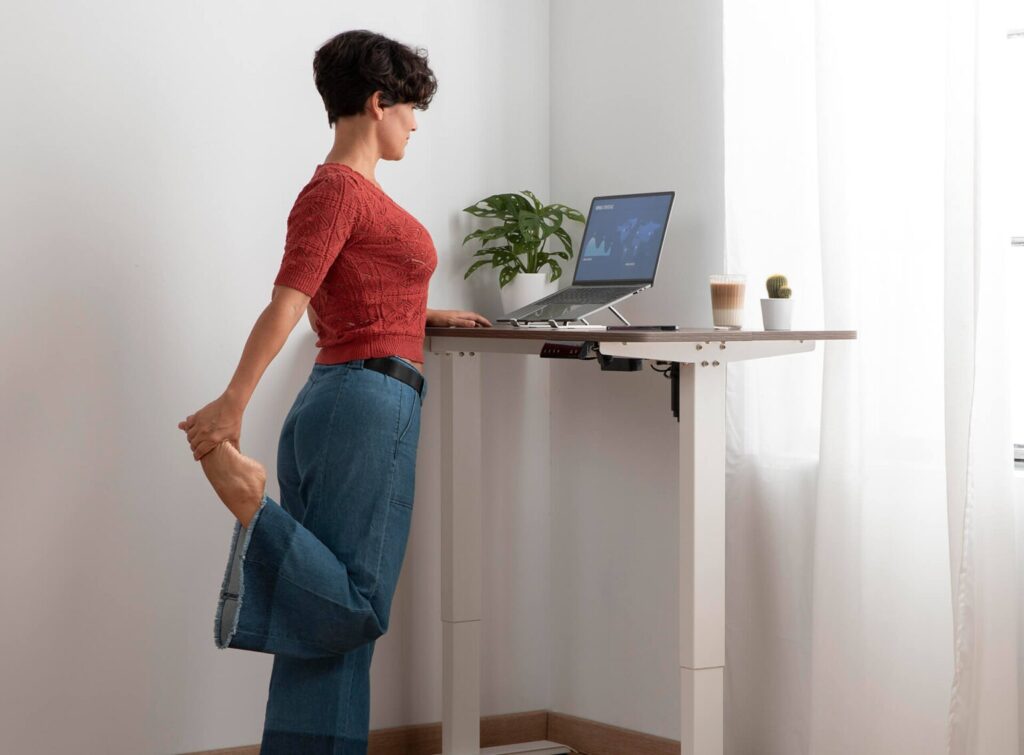Lower back pain is a common complaint among office workers who spend most of their work day sitting in front of a computer. The sedentary nature of desk work and poor posture can lead to stiffness, tension, and pain in the lower back. Individuals whose job involves frequent bending or twisting are more susceptible to experiencing back pain. Statistics show that a significant proportion of the adult population experiences back pain, with up to 80% of people experiencing it atleast once in their lives, and about 20% suffering from it in a single year.
Back pain can have several causes, but three of the most common ones are:
- Poor posture: When you have poor posture, it puts excessive stress on the muscles, ligaments, and joints in your back. This added strain can lead to discomfort and pain. Overtime, the persistent pressure on these structures can result in chronic lower back pain. Moreover, poor posture can gradually cause the alignment of the spine to change, leading to a variety of musculoskeletal issues. Poor posture can result from a variety of factors, such as slouching, hunching over a computer, or standing with your shoulders hunched forward. Other factors that can contribute to poor posture include muscle imbalances, tight muscles, poor sleeping positions, and carrying heavy bags or backpacks on one shoulder.
- Lack of exercise: When you don’t exercise regularly, the muscles in the back and core can weaken, making them less able to support the spine. This can lead to low back pain and injuries. Lack of exercise can also lead to weight gain, which can put additional stress on the spine. In addition, a sedentary lifestyle can contribute to poor circulation and a decrease in bone density, which can also increase the risk of low back pain.
- Injuries: Lower back pain can also result from injuries, such as muscle strain/sprain, herniated disc, kidney stones, ankylosing spondylitis, and other factors,
Here are some tips you can use to reduce back pain:

Fix your posture
- Start by making sure your feet are flat on the ground and your knees are at a 90-degree angle. Your hips should be pushed all the way back in the chair, and the backrest should be adjusted to support your lower back. This will help you maintain a neutral spine position and provide relief on your low back.
- Another important factor to consider is the position of your monitor. Your monitor should be positioned directly in front of you, about an arm’s length away. The top of the monitor should be at or slightly below eye level, so you don’t have to tilt your head up or down to view the screen. This will help prevent neck and shoulder strain, which can contribute to low back pain. When sitting at your desk, try keeping your shoulders back and your chest out. You can also try this simple trick: squeeze your armpits together, which will automatically bring your shoulders back without shrugging them and will also bring your chest out. Avoid leaning over to one side, as it can cause muscle imbalances and contribute to low back pain. Remember, it may take some time to get used to sitting with good posture, but with practice, it will become more natural.
- Just as maintaining good posture while sitting is important for reducing low back pain, so too is proper sleeping posture. Sleeping in a position that strains your back can lead to discomfort and pain. When sleeping on your back, place a pillow under your knees to help maintain the natural curve of your spine. Side sleepers can benefit from placing a pillow between their knees to keep their hips and pelvis in alignment. If you sleep on your stomach, try placing a pillow under your pelvis to help reduce the strain on your lower back. Remember, it’s important to choose a mattress and pillow that support your body and promote proper alignment.

Being active
- Incorporating exercise into your daily routine can help alleviate tension and build strength in the muscles that support your spine. A strong core is particularly important for preventing lower back pain, as it helps support your spine and improve posture. Exercises such as dead bugs, planks, glute bridges, and back extensions can help build core strength.
- Stretching regularly can also help alleviate tight muscles around your back and hips. Some effective stretches include the hip flexor stretch, seated figure-four stretch, child’s pose, cat-cow stretch, and lats stretch. If you are new to stretching, start slowly and hold each stretch for 30 secs – 1 minute on each side.
Taking frequent breaks from sitting is crucial for preventing and reducing lower back pain as it can put alot of pressure on your lower back when sitting for an extended periods of time. Standing up, stretching or walking around can help alleviate this pressure and keep your muscles loose and limber. Even simpler exercises such as doing leg lifts while sitting at your desk can help increase blood flow and alleviate tension in your lower back.
Manage stress
Stress can cause tension in your muscles, including those in your back. Finding ways to reduce stress, such as through exercise, meditation, or talking to a therapist, can help alleviate this tension and reduce your risk of developing low back pain.
By incorporating these tips into your workday, you can help reduce your risk of developing lower back pain and maintain a healthy, pain-free back. Remember that it’s important to listen to your body and seek medical attention if you experience persistent or severe back pain.

